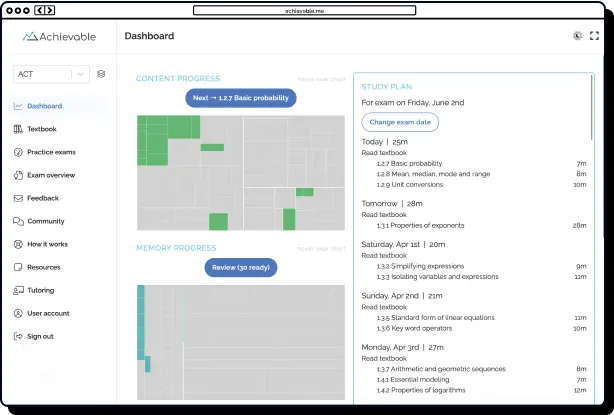
AMC 8: Practice questions and solutions




Do you need help studying for the AMC? You have come to the right place! Below are some practice problems and solutions focused on geometry and logic, covering key concepts for both mathematical areas.

What is the AMC?
The American Mathematics Competition (AMC) is a distinguished math tournament for students in grades K-12. The AMC 8, in particular, is a 25-question, 40-minute competition targeted toward 8th-grade students or younger. The exam covers middle school math topics, from counting and probability to elementary geometry. We have selected a series of questions that closely reflect the style and difficulty of questions found in the AMC 8, along with their solutions and explanations.
Geometry questions
Problem 1
Imagine five overlapping squares with side lengths 4, 5, 6, 9, and 10 inches. They are aligned such that the bottom-left-most corners of all of them line up (see figure below).

Calculate the area of the orange region in square inches:
A) 42 B) 34 C) 46 D) 54
Solution 1
The correct answer is: C) 46
To find out the area of all the orange regions, we will calculate the three parts individually and then add them all together.
Let’s begin with the largest square, which forms the background: its area is 102 = 100 square inches. Since the 9-inch square partially covers this area, we subtract its area (92): 100 - 81 = 19. This gives us the area of the outermost orange region.
Next, we find the orange strip between the 6-inch and 5-inch squares. The visible orange area is the difference between their areas: 62 - 52 = 11 square inches.
Finally, the smallest 4-inch square is fully visible and orange, so its full area will get added: 42 = 16
Adding all visible orange areas together, 19 + 11 + 16 = 46, we get the answer of 46 square inches.
Problem 2
A square with a side length of 6 units is inside a circle such that the corners of the square touch the outer edges of the circle. What is the area in units squared of the circle?
A) 18π B) 36π C) 6π D) 9π
Solution
The correct answer is: A) 18π
Let’s go through one way of getting to the answer. If a square is inscribed inside a circle, the diagonal of the square will be the diameter of the circle. By splitting the square into two right triangles and using the Pythagorean theorem (a² + b² = c²), we can calculate the length of the square’s diagonal:
6² + 6² = c²
72 = c²
C = 6√2
So, the diagonal of the square (and diameter of the circle) is 6√2. To get the radius of the circle, we divide that by two: 3√2
Now that we have the radius, we just plug it into the formula for calculating the area of a circle, πr2: π * (3√2)2 = 18 π

Logic questions
Problem 1
On Wednesday, Timothy had $3. Each day, he will either gain $2 or double his current amount of money. How many possible amounts of money could Timothy have on Saturday, three days later?
A) 7
B) 8
C) 6
D) 12
Solution
The correct answer is: A) 7
Let’s break down this classic example of an AMC 8 problem step by step:
Wednesday
Timothy starts with $3.
Thursday (one day later)
On Thursday, using typical strategies found in AMC 8 practice problems, Timothy can either add $2 to his total or multiply the previous day’s amount by 2.
- (3 + 2 = 5)
- (3 x 2 = 6)
Possible amounts: [5, 6] dollars.
Friday (two days later)
We repeat the process with both possible amounts from Thursday. This systematic approach mirrors the logic needed for many AMC 8 problems and solutions.
- (5 + 2 = 7)
- (5 x 2 = 10)
- (6 + 2 = 8)
- (6 x 2 = 12)
Possible amounts: [7, 10, 8, 12] dollars.
Saturday (three days later)
From each amount on Friday, Timothy again has two choices: add $2 or double the money. This recursive decision-making is common in AMC 8 practice problems.
- (7 + 2 = 9)
- (7 x 2 = 14)
- (10 + 2 = 12)
- (10 x 2 = 20)
- (8 + 2 = 10)
- (8 x 2 = 16)
- (12 + 2 = 14)
- (12 x 2 = 24)
Possible outcomes: [9, 14, 12, 20, 10, 16, 14, 24] dollars.
To determine how many unique amounts Timothy could have on Saturday, notice that the value “14” appears twice. That leaves us with seven distinct amounts: [9, 10, 12, 14, 16, 20, 24].
Problem 2
Assume that the following statements are all true:
i) All yellow things are round
ii) Some round things are green
iii) All green things are spiky.
When practicing AMC 8 problems, especially those involving logic or geometry, it’s important to analyze the relationships between different statements carefully.
Consider the following statements:
- If something is yellow, it must be round.
- If something is round, it is yellow.
- Some things are spiky and yellow.
- If something is green, it is spiky and round.
- If something is green, it could be round.
- Some things are spiky, square, and green.
Which of these are logical consequences of i, ii, and iii?
A) 1, 3, 4, 5
B) 1, 5
C) 1, 3, 5, 6
D) 1, 3, 5
Solution
The correct answer is: B) 1, 5
Let’s break down each statement using logical reasoning skills that are often tested in AMC 8 problems and AMC 8 practice problems:
- If something is yellow, it must be round.
This is a direct logical consequence of statement i). All yellow things are round, so this closely matches the premise.
- If something is round, it is yellow.
This does not follow logically from the premises. Just because all yellow things are round does not mean all round things are yellow.
- Some things are spiky and yellow.
There is no connection provided between yellow and spiky items in the given statements, so this is not a guaranteed logical consequence.
- If something is green, it is spiky and round.
The premises confirm that all green things are spiky (iii), but not necessarily round. While some round things are green (ii), not all green things are round.
- If something is green, it could be round.
This follows from statement ii): since some round things are green, it is possible for a green thing to be round.
- Some things are spiky, square, and green.
The initial statements do not mention squares, so this cannot be concluded.
Wrapping up
The AMC practice problems above provide you with a sense of the style of questions you can expect on the official exam. The AMC is not intended to be a straightforward math test, but rather an opportunity for you to demonstrate your critical thinking skills through multi-step problems. For these types of questions, the best way to improve your comprehension and speed is by completing AMC 8 practice problems and exams regularly. Building a strong foundation in geometry and logical reasoning at the middle-school level is just one part of the equation: you must be able to answer questions in less than a minute to fully complete the test. Luckily, with targeted practice and the right guidance, you can develop the thinking and tools necessary to approach each problem efficiently.

